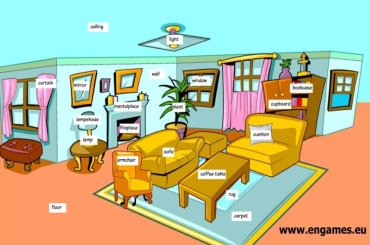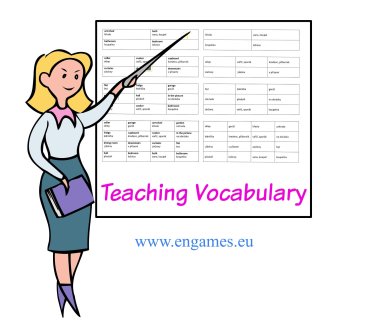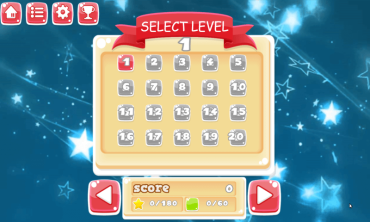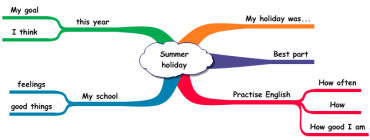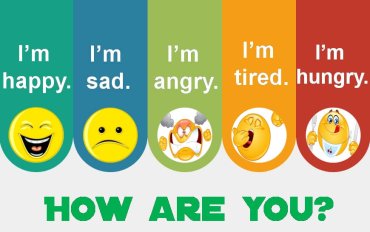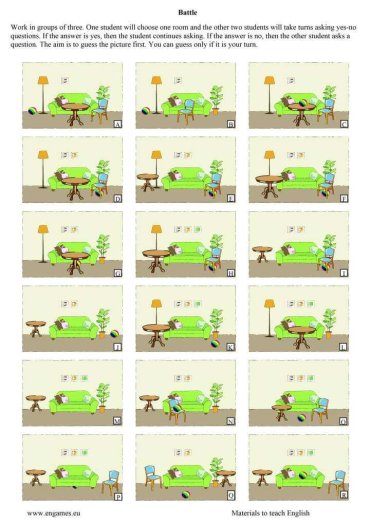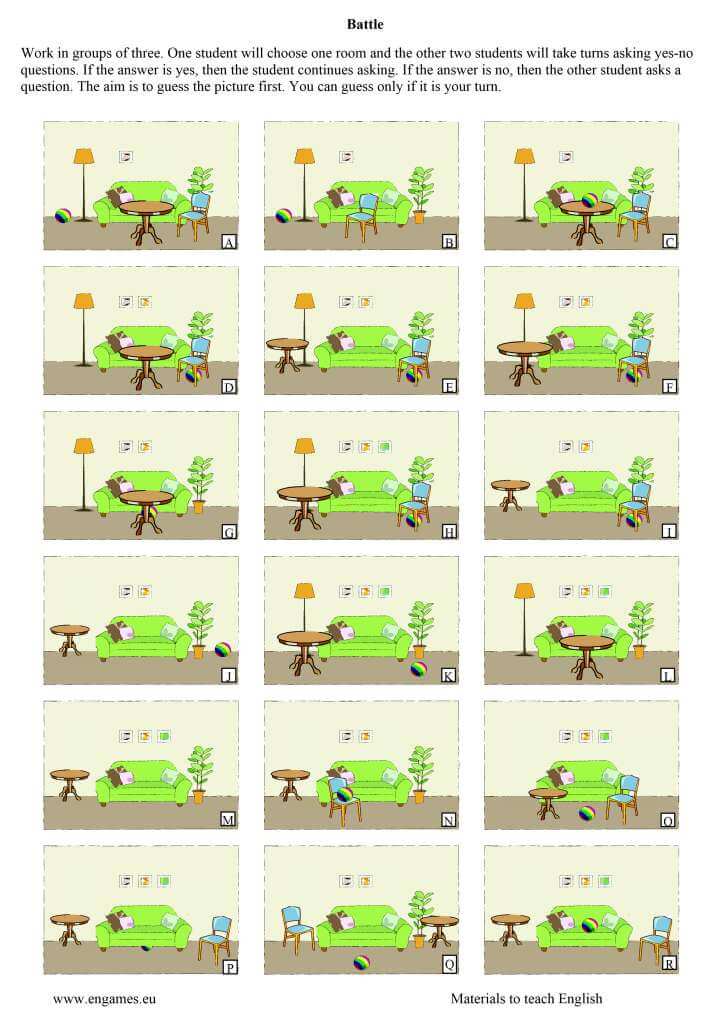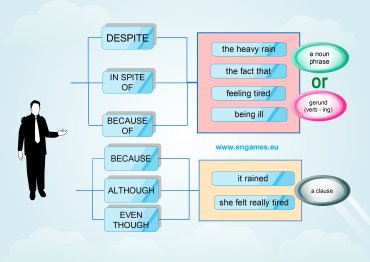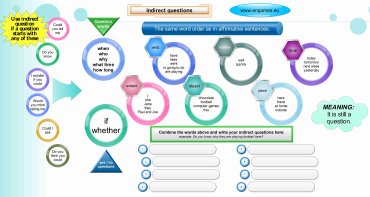Graded readers are believed to be extremely useful for learners of English. Many research reports show that learners improve substantially if they read a lot of simplified books. In this post, I would like to share a Graded Reader Comic. It is a Sherlock Holmes story called The Final Curtain. The comic is just six pages long and is suitable for elementary and pre-intermediate learners of English.
ADVERT:
[showmyads]
Sherlock Holmes – The Final Curtain – Graded Reader
I took the original comic, improved the quality of the pictures and simplified the dialogues. You can download and print the graded reader here:
If you prefer video, you can watch the video of the comic here. There is no sound but you can ask your students to read the bubbles aloud.
Graded Readers – research
At the end of the period, I gave the students the Level Vocabulary Test by Paul Nation and then my colleague gave the same test to another group of 10-year-olds who study the same textbook. My group knew 10% more words than the control group, but the other group scored better in a grammar test. So, I am not convinced that graded readers are the best thing. But as they do not harm my students, I will keep on using them.
If you are interested in more research on graded readers, you can find it here.
“He must be joking!” I thought. I was shocked but I kept quiet. My friend Jane didn´t.
“Why the hell should I throw all my work away?” she asked. We went silent and expected that Jane will be punished.
(more…)Vocabulary is much more important than grammar. If you know the meaning of the words you can understand a text even without knowing the grammar. If you listen to a recording and you know the vocabulary, you will understand the meaning of the message.
<!– wp:more –>
If you watch a video and understand the words, you can enjoy the film. However, if you know just the grammar you will not understand much. Therefore, we should devote a lot of classroom time to teaching vocabulary.
Unfortunately, most of us don´t spend much time teaching vocabulary. Many teachers of English assign vocabulary as homework and students have to learn the words at home. It is not an entirely bad method. My research shows that 50% of students actually learn the vocabulary on their own. The bad news is that the other half of students don´t do it. They do not learn the vocabulary and after a while they are completely lost. That´s why I think that we should teach vocabulary at school.
ADVERT:
[showmyads]
All the best experts on teaching vocabulary, like Paul Nation or Keith Folse, agree that the best way to teach foreign vocabulary is by using translation. It is the best way for our brain to remember the vocabulary. And in this post, I would like to share with you two methods I have been using to teach vocabulary in my classes. Both of the methods are very effective.
Teaching vocabulary – Remembering Tables
In my article in the magazine English Teaching professional (issue 105), I share with the readers the Remembering Tables method of teaching vocabulary. To do this in your class you need to prepare tables similar to the following:
In the tables on the left, the words are given in both English (in bold letter) and in MT (in this case in Czech). On the right, the tables contain only the Czech words.
At the beginning, read the words in the first table and ask the students to repeat them. Then give the students 20 seconds to study and memorise the words. After this time, they should cover the table and write the words into the table on the right. When they have finished, they uncover the table and check their answers. You go on like this with the rest of the tables, giving the students 30, 40 and 45 seconds respectively.
It is a great classroom activity, but the preparation is a nightmare. To simplify it, I asked a friend to make a word macro which would do all the work for me. And here is the result:
Download the file. Then create a text file which contains 16 lines – use Notepad for this. On each line there is the word in English the plus sign and the word in the students’ mother tongue (e.g. work+pracovat). Save the file. Then open the downloaded macro. It asks you to Select Text File Containing Words. Click SELECT and choose the txt file you have created. And bingo, your tables are finished and you just print them.
Teaching vocabulary – vocabulary books
I teach a group consisting of challenged children. Some of them live in bad conditions, some of them have really low IQ and some have behavioral problems. They are fine, but their test results are appalling. But this week I experienced a great teaching success. These students remembered over 80% of the words I taught them. While previously they scored about 50% on average, this time they were nearly twice as successful.
How did we achieve this? I prepared the following vocabulary books for them.
I printed this as a brochure and then I made small books out of it. I handed them out and I asked the students to complete the tables in their free time during my lessons. In the tables with the free lines, students should copy the English words twice and the Czech translation once.
In the other tables, students have to translate the words. If the word is in English, they translate it into their MT and if the word is in their MT they translate it into English (this is 3 times as frequent as the former translation).
The preparation took some time, but the results were fantastic. Try it out and you will see for yourself.
Category: English games
Mobile phones are bad! Students spend hours on mobile apps and they do not learn! What can we do about it?
I tried to do something about it. I prepared a responsive website for my students to learn on their mobiles and … they didn´t come.
<!– wp:more –>
But then I created my first android app and everything changed. I became a school hero and students have been showing me their mobiles with my app on them.
And I wondered: Why do they suddenly learn on their mobiles?
ADVERT:
[showmyads]
The answer is simple. Data is expensive and when the students decide to use the internet, they do it to socialize. And let´s be honest, my static website is no competition for sites like Facebook or Instagram.
But as the app does not require the internet connection, it sits in their mobile phones and waits for the moment when the students disconnect. And then the students start to play the vocabulary game. Several factors play their role here. First, students can use their mobile phones, second, no one blames them that they do not learn, and third, they make their parents and teachers happy by playing a mobile app on their phone.
The application – explanation
So what does the “miracle” application do?
It is quite simple. There appears a word on the screen in students´ MT and they have to type the word in English. If they answer incorrectly the correct answer is shown, and the word gets repeated after a while.
There are sixty levels and students get points and stars for their performance.
You can download the mobile app at Google Play. It is called “Top 450 slovicek v aj final“.
In my application they learn 450 most frequent words in English. You can see the screenshots here:
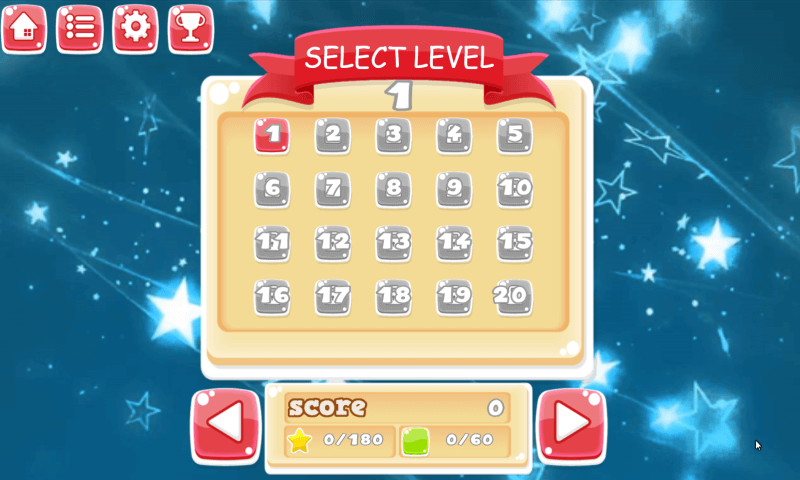


My first mobile app – Free app for you
As this app is incredibly easy to customise, I can offer you the following: If you send me a text file with 450 words + their translation or definitions I will make an app for you which you can offer your students.
I will do it for free.
The only thing I want is, that I may later use the text file in any way I want.
Category: English games
Giving directions in English is one of the most useful functions there is. Everyone understands that this is the function they are likely to use on the street, literally, and therefore the motivation is usually quite easy.
To be able to give directions you need to learn a set of phrases which you later combine into a conversation. To teach the phrases we offer you the following. A simple drill (teaching the basic phrases), an infographic, several worksheet activities and an interactive quiz.
Giving Directions in English – Video
First watch and repeat the phrases and then produce the phrases before the native speaker says them.
ADVERT:
[showmyads]
Giving Directions in English – Infographic
It is always a good idea to give students a handout with all the phrases you want them to learn. Thus they can revise the vocabulary and there is higher chance that they will learn the phrases. Here is a colourful infographic with the phrases from the video.
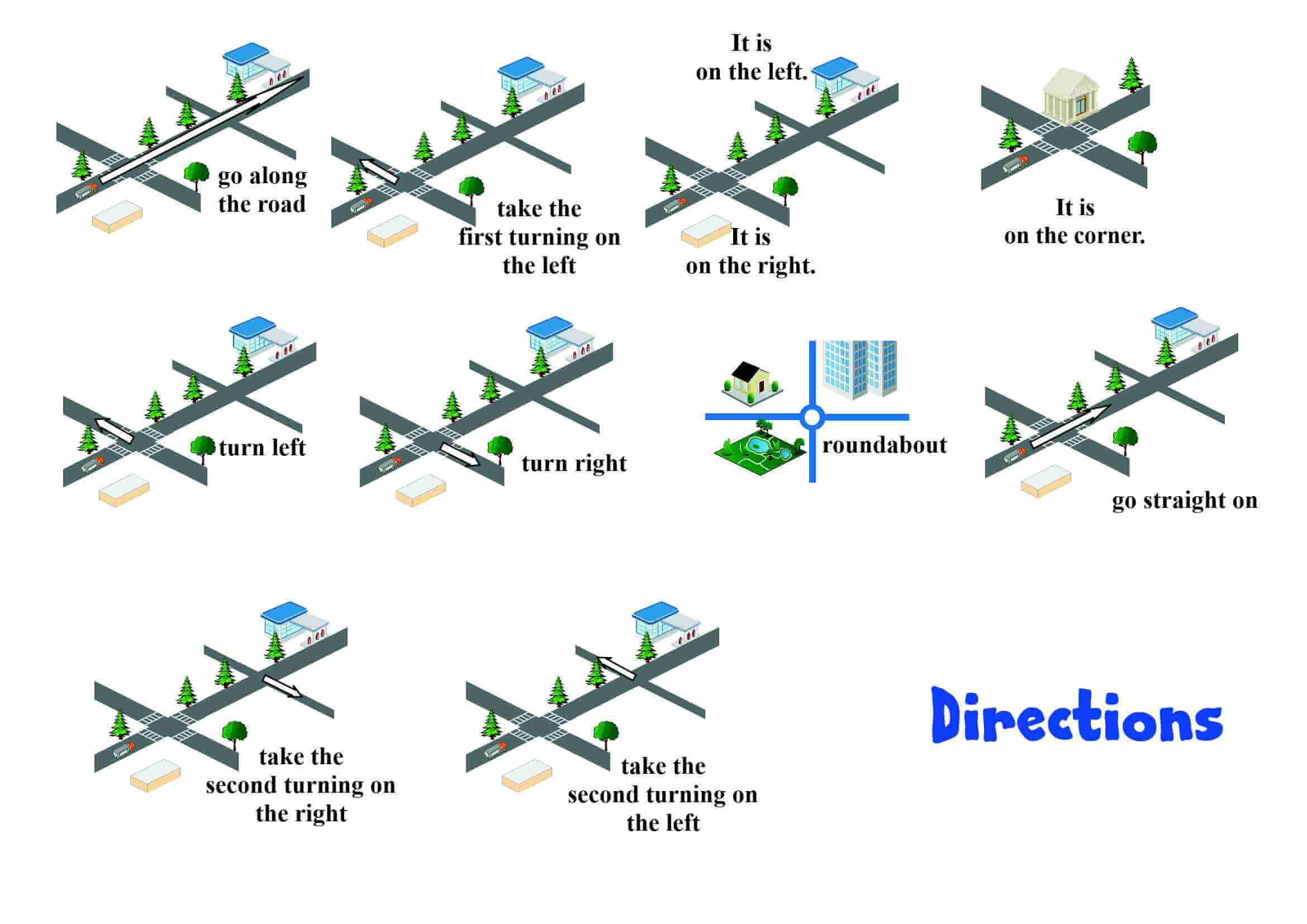
You can download the full-size picture here:
Directions – full size picture
Giving Directions in English – Worksheet and quiz
First of all I would love to recommend the following worksheet by Mary Glasgow plus. In this worksheet students practise their divisions and directions too. You can download extra instructions for the same worksheet here.
Directions for Maryglasgow magazine
The following worksheet gives students a chance to use the new phrases. Print the following map and give one to each student. The students draw a trail into their map (from the start to any place they like) and then they give instructions to their partners who must draw the same trail into their map. At the end they compare their maps and discuss any misunderstanding.
The following quiz can help your students practise giving directions in English. They can do it either at school or at home. The quiz consists of two parts. In the first part, students should match the phrases and the instructions. In the second part, students have to type the missing words in the phrases. The students will be rewarded with a game after each part of the quiz they pass. The quiz is in HTML5, so it will play on all desktops and mobile devices.
Giving directions – links
There are some wonderful materials on giving directions at British Council site. Check them out.
The school year is starting and the summer holiday is over. Students are returning to their classrooms and we have to teach them. And I think that many of us would like to teach better than last year. So let’s start with a great speaking activity about the summer holiday.
ADVERT:
[showmyads]
The original idea comes from Larry Ferlazzo and you can find the original worksheet here. Larry was so kind to allow me to use his idea and worksheet and modify them. In this post you will find a video, a worksheet and instructions how to use them.
My Summer Holiday – video
Start with the following video. Ask the students to read, listen and repeat the sentences as instructed in the film. Play the video at least twice and do not worry if the students are not able to repeat some of the phrases in full. It is enough if they try.
My Summer Holiday – worksheet
You can find the original worksheet by Larry Ferlazzo here. Larry was so kind to allow me to change the worksheet and use it here.
My summer holiday worksheet
Print the worksheet so that the text is on one side and the colourful mind map is on the other.
Ask the students to complete the worksheet with their own ideas and experience. In some cases they can find several suitable expressions in the brackets but they can use their own words if they want to. There are several gaps with no help and students have to use their own words there.
ADVERT:
[showmyadsa]
Once students complete the worksheet, they work in pairs and read their version to their partner. When they finish, ask them to have a look at the mind map on the other side of the paper. Explain that the mind map sums up the whole text. Demonstrate that you can easily retell the text using the mind map.
Ask the students to work in pairs again and retell their Summer Holiday story. Change pairs and students retell their story again. Do not prevent students from looking at the original worksheet if they feel they need to. They will copy the phrases and thus learn them.
Now it is time to play the video again and the students should be able to remember much more than the previous time. Play the video at least twice in the following lessons.
Yesterday English Through Music published an awesome song called “How are you?”. As the song is easy to remember and sing, I contacted Jules and asked him for a permission to write a post around the song. He kindly agreed and here you can see the result.
ADVERT:
[showmyads]
This post is mainly for beginners or very young learners of English. It contains the song, an infographic and a simple quiz with games. Moreover, there are several suggestions how to exploit this wonderful materials more.
How are you? – song
The following song was written and published by English Through Music. You can find their website here and there are more wonderful songs at Youtube English Through Music channel.
First listen and sing along:
Other activities you could do:
a) ask the students to perform an action for each of the adjectives (happy – smile, angry – pretend to be angry, etc.)
b) ask the students to listen and draw a picture for each adjective.
c) ask the students to mingle and ask each other “How are you?” and their partner must answer.
I am sure there are many more activities you will come up with. If you do, please share them with us.
Moreover, English Through Music promises to come up with an action video for the song soon.
Past simple and continuous – infographic
Here I have created a simple infographic for learners to take home with them. It presents all the vocabulary taught in the song in a simple and clear way. Pupils can use it to revise the vocabulary at home.
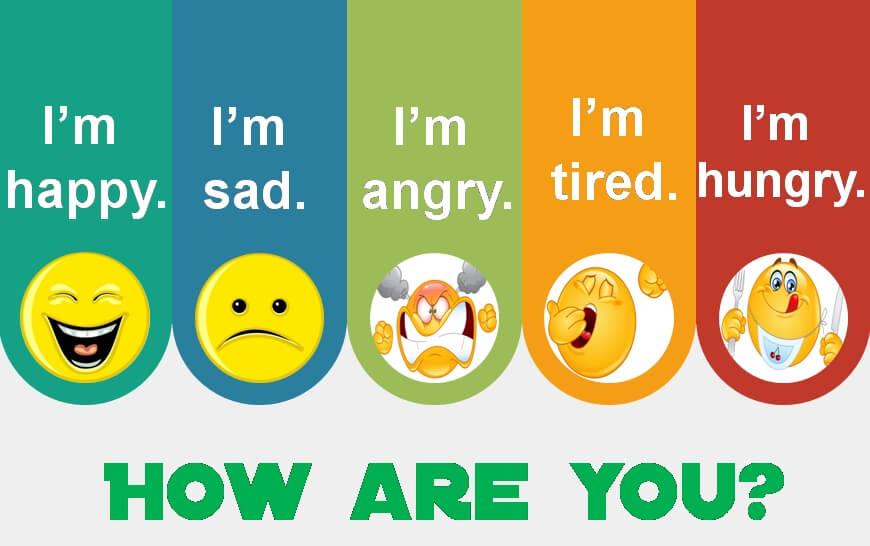
How are you? – Quiz
Another way in which students can practise what they learnt at home is the following interactive quiz. Of course you can use it at school, too.
The quiz is in HTML5, so it will play on all electronic devices.
ADVERT:
[showmyadsa]
In the first part, students match the pictures and the adjectives. If they succeed they will be rewarded with the game called angry finches.
In the second part they have to write the appropriate adjective into the gap provided. If they pass this quiz too, they can play the game called Math Pop and practise their Maths.
Recently, in the post called Questions with Like, I asked you to choose the activity you would like me to write about. Most of you voted for a Speaking activity, so I prepared a set of speaking activities to practice the prepositions of place.
I have already created a post on prepositions, so this time there will be no infographics just two speaking activities. If you are looking for more speaking activities, you can find a two great speaking activities here.
ADVERT:
[showmyads]
Speaking activities – Battle
The first activity is called Battle and it was devised and recommended by K. Folse in his book The Art of Teaching Speaking.
First, print out the worksheet with 18 pictures. Each picture is different and they are labelled with letters A to R.
Ask students to work in groups of three. They should label themselves A, B, and C. Student A starts.
Student A will choose a room in the worksheet. Then students B and C will take turns asking yes – no questions to identify A´s room. For example, B asks: “Is the table in front of the sofa?” If student A answers “Yes, it is,” student B asks another question. He continues in this way till student B answers “No.” Then it is student´s C turn. Students go on like this till someone identifies the picture student A is thinking of.
After student B or C has guessed A´s room, student B chooses a room and students A and C try to guess it in the same way as they did with student A.
Students keep track of how many rooms they guessed correctly, and the winner is the one who guessed most.
Here is the worksheet students will use (it is enough to print out just one worksheet for each group.)
Speaking activities – Language needed
To be able to do the task above successfully, your students need to know the following vocabulary and grammar:
Vocabulary: plant, picture, lamp, table, cushion, plant, sofa, floor, wall, chair, ball and the prepositions of place (you find the materials to teach Prepositions of place here).
Grammar: to form question with is/are and the phrases There is / there are.
If your students do not know the language mentioned above, the speaking activity will not work!!!
Speaking activities – Drawing a Picture
First you need to print out the following worksheet once for each pair of students. They should cut it in the middle and each student should keep one sheet. (Now each student has two pictures with the room.)
Then, each student draws between 5 and 10 objects into one of his pictures. He or she has to draw objects they know the English words for. I personally ask my students to draw pieces of furniture we learn in the textbook unit.
Students sit with their backs to each other and one describes their picture for their partner, and the partners draws the objects into the picture he or she has not drawn into yet. When one student finishes they swap their roles and the other student describes their picture.
At the end the students compare their pictures.
Here is the worksheet:

ADVERT:
[showmyadsa]
To be able to print out the worksheets in the best possible quality, use the following pdf file:
Speaking activities pdf worksheet prepositions of place
Speaking activities – Language needed
To be able to do the task above successfully, your students need to know the following phrases:
Can you repeat that?
Tell me again.
Where does the …. go?
Speaking activities – Conclusion
I hope you will find both of the speaking activities useful and interesting, and that they will make it into your classroom. Both of the activities should ensure that your students will produce a lot of language and they will practice their knowledge of prepositions of place.
In this post I would like to teach you how to use the words DESPITE, IN SPITE OF, ALTHOUGH, EVEN THOUGH, BECAUSE OF and BECAUSE correctly. I will explain the meaning of the words and the grammar. To help you with this there are two games, a mind map, a video explanation and a graphical explanation. I hope you will learn to use these conjunctions.
ADVERT:
[showmyads]
Conjunctions – meaning
The meaning of the conjunctions DESPITE and IN SPITE OF is the same. ALTHOUGH and EVEN THOUGH are the same as well. And so are the meanings of the words BECAUSE and BECAUSE OF. As you will see later the main difference between these words is their grammar.
The meaning of these conjunctions is clearly explained in the following graphics:
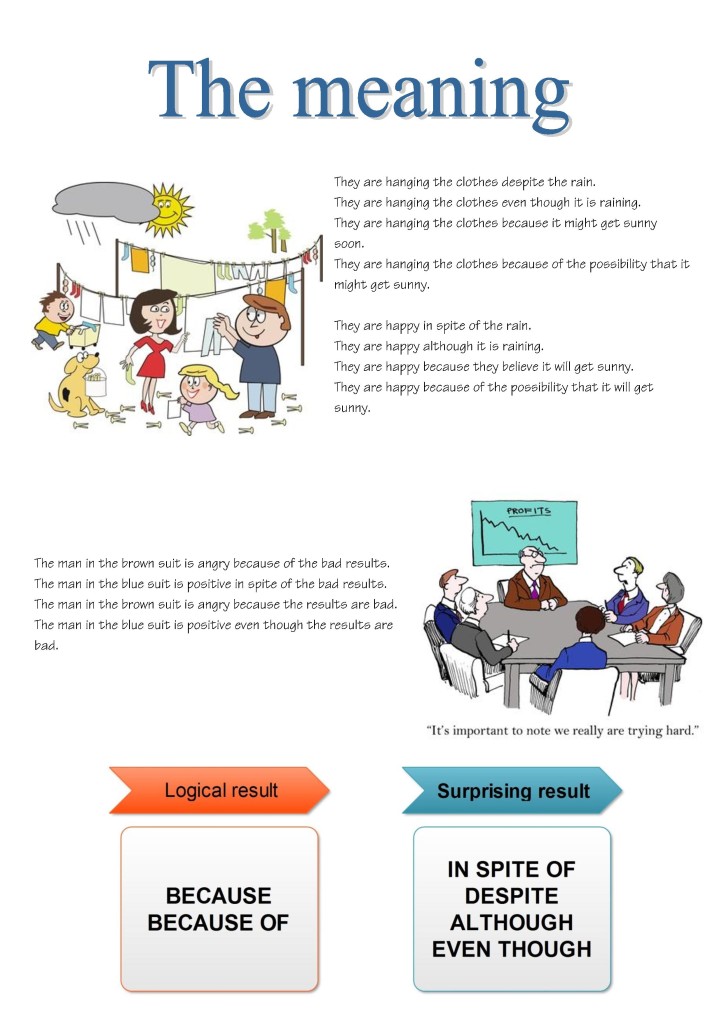
If you want to print out the graphic, you can download the pdf file below:
Conjunctions – the usage
As I write above, the main difference between the phrases is their usage. To cut the explanation short, the words DESPITE, IN SPITE OF and BECAUSE OF are followed by a noun phrase or a gerund (verb + ing). The conjunctions BECAUSE, EVEN THOUGH and ALTHOUGH are followed by a clause.
You can see the explanation again in the following mind map:
To make it absolutely clear, here is an interactive video explaining the usage of the words BECAUSE and BECAUSE OF.
This video uses the free recording offered by BBC learning English at http://www.bbc.co.uk/worldservice/learningenglish/radio/specials/165_gramchallenge10/
To experience the video full screen click on the following button (as it is HTML5 video it will work on your mobile too):
BECAUSE – video explanation
ADVERT:
[showmyads]
Conjunctions – quizzes and games
The first game is slightly easier but it can be played only on your desktop. It is called Hoopshoot and your task is to choose the correct conjunction. If you succeed you will be given a chance to score a basket.
The second quiz is fully in HTML5 so it will play on any mobile device you own. Your task is to connect both of the sentences into one and use the conjunction in the brackets. If you pass the test you will play the game called Math Pop and practise your Maths too.
When students hear the phrase indirect questions, they get scared. But actually this is one of the easiest grammar points in English. The only thing you have to watch out for is that if a sentence starts with a certain phrase (Do you know or Could you tell me etc.) you have to use the word order for an affirmative sentence. To put it simply, after the aforementioned phrases do not make questions.
ADVERT:
[showmyads]
To help you master this grammar there is a mind map, a video and several games in this post.
Indirect questions – video
The following video is based upon BBC learning English recording. To make it easier for learners of English to follow I have added the text and illustrations.
We recommend that you watch the video and stop the recording every time there is a task and answer the task before MASA does. It is a great fun and a superb way to learn English.
If you want to watch it full screen, click here:
Indirect questions video
Indirect questions – mind map
The following mind map tries to show the rules for indirect questions in a graphical form. As you can see each indirect question has to start with a phrase signalling that it is an indirect question. Then you use a question word or IF/WHETHER (if there is no WH.. word) and the word order of a normal statement.
ADVERT:
[showmyads]
Indirect questions – games
Now it is time to practise what you have learnt in the following games. The first one is a quiz with two games. If you answer the quiz correctly you can play the games called Angry Farmer and Math Pop. Both the quiz and the games are in HTML5 so you can play them on your mobile phones.
The second game is in Flash and it will play only on your desktop. It is the notorious On target game. If you choose the correct option you will be given a chance to shoot the bad ducks. Moreover, you can get a bonus if you shoot one of the bottles on the sides. Enjoy.
Vocabulary videos
On Youtube we have created a new channel which contains all the vocabulary videos we have created. Here are some of them. So do not miss them:
You can learn the words connected with the environment at http://youtu.be/PbBR1sNc6C4
There is a vocabulary video introducing the Town features at http://youtu.be/5Plh_LBjwks
At http://youtu.be/c0T5j-5MEg8 you can learn some vocabulary to speak about Plants in English.
For young learners we have some names of Animals at http://youtu.be/wb6Ctlvz0Ys
If you want to learn more vocabulary on Sports you can go to http://youtu.be/14_5rLiIAm0 and learn the names of Winter Olympics sports
At http://youtu.be/9IWZb61DG1M you can learn Clothes Vocabulary
Furniture vocabulary is presented at http://youtu.be/7VOpE1n74h0
One of the most difficult parts for learners of English to learn are personal qualities.
To help you with this, you can try the video at http://youtu.be/3KisHI5O6WY
Category: English games, Grammar, Intermediate
EFL, English, ESL, games for indirect question, Grammar, grammar games, indirect question, indirect questions explanation, indirect questions grammar, indirect questions mind map, intermediate, intermediate students, learn, learn English, learning English games. English learning games., mind map, school, students, TEFL, TESOL


